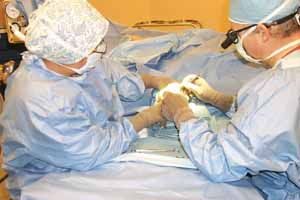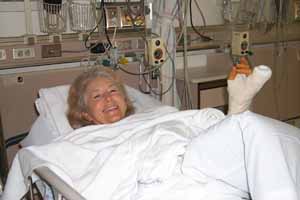First posted June 19, 2000 Last updated May 17, 2019
Post-Operative Instructions
How do we go from this (above) ....................................to this (happy patient with no pain)?
Read on!
Instructions for My Patients after Hand Surgery
Your post-operative recovery period is an essential part of the entire process of surgery and a return to optimum function. Your recovery is very important to me and I know it is important to you. I have discussed your recovery period with you at the time we decided that surgery was the option for you, but I want to give you some written guidelines and instructions to take home. I think that these will help you through your recovery period.
I will discuss the nature of your surgery, all the findings, and what I think that the future holds when you come in for your first post-operative checkup. For now, here are some instructions for a successful recovery!
- Pain is usually one of a patient's first thoughts about surgery: Is this going to hurt? How much is it going to hurt? I know that post-operative pain is important to you and I want you to know that it is important to me, too. I have studied the post-operative pain of my patients for several years and have worked out a system that has been highly satisfactory to the patients. (See the Post Operative Pain Management Page for the results of my pain study: 46% of the patients over a 3 year period did not need to take any narcotic pain medication!) I will almost certainly (very rare exceptions, such as infected cat bite) give you a long-acting numbing shot just before we leave the operating room. This means that your arm or hand should be profoundly numb for about 4 to 36 hours after surgery, and possibly somewhat numb for longer. Do not let this numbness alarm you. Numb right after surgery sounds like a great idea to me! (That is why the patient in the picture at the top right of this webpage is smiling: my numbing shots are very effective!) Be careful not to burn yourself (such as holding a hot cup of coffee) or hurt yourself while your hand is numb.
- You should take Aleve 220 mg as I discussed with you in the office. You can find my general post-operative pain protocol here. I recommend that you take this medication whether or not you hurt, since it is easier to stop a pain from starting than to stop it after it has started. Do not take Aleve if your doctor has instructed you not to take antiinflammatory medication. You should also be taking Tylenol Arthritis 650 mg (acetamenophen) along with the Aleve, unless your doctor has told you not to take Tylenol (acetamenophen). Most patients can take up to a maximum of 3000 mg of acetamenophen per day. Discuss the dose of Tylenol with me prior to surgery. Aleve and Tylenol are in different classes of pain medication, and when you take them both together, they work much better than either one alone. It is a case of 1 + 1 = 3 in terms of the effectiveness of the medication, that is, one Aleve and one Tylenol are more powerful in relieving pain than two Aleve alone or two Tylenol alone. The medical term for this is "synergistic."
- If you need to take the prescription pain medication, you should continue to take the Aleve and Tylenol. They work much better together than any one of them alone.
- My patients tell me that elevating their arm above the level of their heart is more effective in relieving pain than any medication. Elevation also helps to prevent swelling, which will decrease your ability to move your fingers later on. Therefore, keep your arm elevated above your heart for two to three days after surgery. If putting it up at shoulder level is not sufficient to help the pain, put it up higher (the "Statue of Liberty" position). I know that it is hard to keep your arm elevated once you fall asleep. Just do the best you can. A sling does not keep your hand above your heart, so I usually don't recommend one unless you cannot control your arm due to the anesthestic.
- You should already have a follow-up appointment, usually about 10 days after your surgery. If not, please call the office to schedule one.
- Keep the dressing clean and dry. Use a plastic bag while showering.
- The instructions on when to remove the dressing is in your printed postoperative directions that I gave you in the recovery room, printed on my letterhead. On the page I will give you, it will say "If this box is checked , take your dressing off in three days and cover the incision with a bandaid". A little antibiotic ointment (Bacitracin, Polysporin, etc., available without a prescription) is also a good idea. The printed directions will also tell you when you can get your incision wet, but only in a shower. Do not get it wet in a pool, tub, lake, aquarium, etc.
- The instructions I will give you alternatively may say, "If this box is checked , or no box is checked, do not change your dressing until I see you in the office."
- A little swelling and redness is normal. If you have redness, swelling, or drainage like an infected scratch or pimple, this may not be normal and may be a sign of infection. Check out the Incisions Page to see what normal incisions look like. The bottom of the page also has a link to pictures of infection. If you still have a question, you should call the office and discuss it with me.
- A fever greater than 101.5°F is abnormal. If you think that you have a fever, take your temperature with a thermometer. Call me if it is over 101.5°F.
- You will usually get some black and blue discoloration around the area of the incision. It will travel down your arm over the next few days (from gravity and elevating your arm). This is normal and comes from blood seeping through the tissues.Check out the Bruising Page for a picture. If you feel that it is an abnormal amount, call me.
- Nausea and vomiting are unusual after hand surgery, due to the nature of the surgery and the nature of the anesthetics that we use. Most often it is occasioned by eating just before leaving the hospital and then bouncing around in a car. Give yourself some time between eating and leaving the hospital. If you get nauseated or vomit, give yourself some quiet time and it usually resolves.
- You should return directly home and rest for the remainder of today, the day of surgery. You should not drive for at least 24 hours, and do not drive until you are confident that you can drive safely. There is no reliable way I can say when it is safe for you to drive, you need to be honest with yourself. Don’t drive if you feel you are not safeTo drive, this is your decision, not mine. You should not make important personal or business decisions for at least 24 hours. Do not drink alcoholic beverages for at least 24 hours and not at all if you are still taking any narcotic pain medication.
- Do not resume normal activities unless instructed.
- I have tried to cover the usual questions that my patients have asked me over the years with the usual answers. I cannot cover all questions and all situations. Use your judgement: complications are rare, and serious complications are very rare. If you need to call, try to do so during office hours, but I am always available to help you or discuss your recovery with you. Your recovery is important to both of us!



